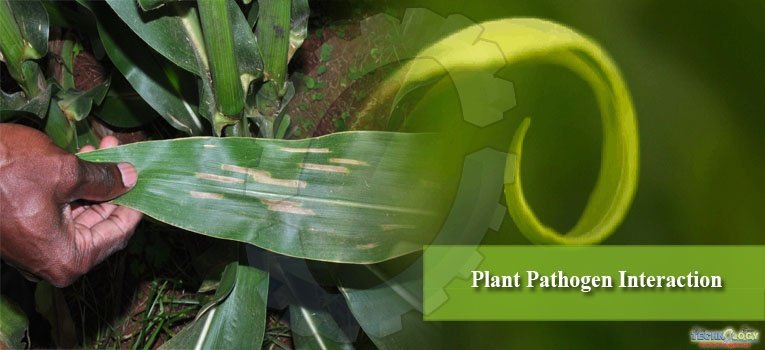Plant pathogen interactions tells us about how pathogen recognizes its appropriate host, plant senses occurrence of a pathogen and what cellular actions follow eventually.

In nature presence of disease is an abnormal incident as in most of the cases plants are resistant (or immune) to most of the microorganisms present around them.
Development of disease needs three basic elements, a susceptible host, an aggressive pathogen and appropriate environmental conditions. Only a few pathogens fit properly into the disease triangle, set up compatibility with host and cause disease in them.
In nature, spores of various pathogenic fungi are present, but tomato plants never get diseased by pathogen causing rust disease of wheat, this shows the specificity of plant pathogen association.
Plants have a two types of defense system; the 1st one is Basal level resistance which is effective against nonspecific pathogens and Specific resistance (Resistance gene mediated following “Gene – for – Gene” hypothesis of H. H. Flor) successful against specific pathogens.
Recognition between plant and pathogen recognition between plant and pathogen are done via receptors present on inside of plant cell which identify molecular patterns produced by pathogen.

Pathogen induce two types of signature molecules;
- MAMP’s (Microbe associated molecular patterns, e.g. Flagellin, EF-Tu), (2)
- Avr (Avirulence gene product, effector molecule).
However, plants also acquire two different types of receptors;
(1) MAMP’s Receptors (receptors which will identify MAMP’s produced by pathogen (eg. FLS2) these are Receptor like kinases (RLK’s),
(2) R gene (which interacts with Avr gene product). In Basal level resistance there is interaction between MAMP’s/ MAMP’s receptors (RLK’s).
This stage of resistance is need by plants to ward off nonspecific pathogens; i.e., pathogens which are incapable to establish compatibility with plant and are eliminated by plant at the very initial stage. Recognition of MAMP’s by plants send off an alarm signal and basal defense of plant is triggered i.e., PTI (PAMP/MAMP Triggered immunity).
In Specific resistance there is association between R gene product of plant and Avr gene product (effectors) of pathogen. This resistance is desired by plants after a pathogen establishes compatibility with the plant and produce disease in it. Now to prevent the pathogen from causing more damage, plant produce specific R Gene which identify Avr gene product of pathogen and triggers ETI (Effector triggered immunity).
MAMPS’s (Microbe associated molecular pattern) These are highly preserved structures present in pathogens which are necessary for their survival and are highly conserved, they have not changed much in due course of evolution. Thus, these patterns even if pose a threat to pathogen, the pathogen cannot discard it as it is a core element for its survival. Its absence affects the fitness and survival of pathogen.
For example, Flagellin in bacteria, EF-Tu in Fungi. Effectors molecules (Avr gene product) These molecules produce attacking capability into a pathogen. They suppress basal defense and make the pathogen virulent. Plants have co-evolved with their pathogens, the R genes of plants are specific to these effector molecules, they have co-evolved with effector molecules to recognize them, activate specific defense mechanism of plants. In nature every effector molecule (Avr1) has its matching resistance gene (R1), “gene for gene hypothesis”.
In absence of a specific R gene in plant Avr gene is effective in causing disease, but when it faces its matching R gene it fails to produce any disease symptoms as R gene renders Avr gene paralyzed. To evade this successful detection of pathogen by R genes of plants pathogen population continues to evolve, mutate and bring about changes in composition and structure of its effector molecules so that the newly synthesized effector molecules are no longer identified by the same R gene.
These molecules are unstable and evolve very fast. The R gene products are a class of NBS-LRR proteins (Nucleotide binding site-Leucine rich repeats). They are two major types CC-NBS-LRR (Coiled coil type) and TIR-NBS LRR (Toll interleukin like type). They sometimes directly associate with pathogen effectors molecules or they guard molecules which are possible targets of pathogen effector molecules.
Any sort of deformation in target host molecule alerts the R gene to come into action. The effector molecules which are identified directly by R gene, evolve/mutate faster to suppress recognition by R gene and poses greater chance to break down of resistance in resistant cultivars than effectors which are identified indirectly by R genes.
Plant Defense Responses
Defense responses of plants can be characterized as:
(1) Pre-Existing Defense Responses: Defense responses which present in plants before pathogen attack. These contains structural defenses (Wax Layer) and biochemical defenses (phytoanticips like saponin).
(2) Induced Defense Responses: Theses defense responses are produced by plants after it recognize occurrences of a pathogen. These include structural defenses (Formation of Cork Layers, tyloses) and biochemical defenses (biosynthesis of phenols).
In both specific and basal level of resistance, the defense response of host plant consists of almost related events. After identification and recognition of pathogen the receptor communicates signal inside host plant cell which amplifies via MAP kinase enzymes and after reaching the nucleus it brings about transcriptional reprogramming of plant cell. The entire performance of a plant cell is reprogrammed.
Under normal situations major energy of plant cell is directed towards production of primary metabolites which are required for growth and reproduction of a plant. But under stressful conditions a cell diverts its flow of energy towards production of certain secondary metabolites i.e. Phenolic substances, PR proteins and an array of various compounds which supply protection to plant cells from pathogen attack.
A flow of biochemical reactions starts which culminates in oxidative burst initiating about programmed cell death. Programmed cell death (PCD) is an example of great resistance response showed by plants in which it destroys its own cells upon recognition of pathogen to deprive the pathogen from nutrition supply and stop its growth.
It is the quality of Hypersensitive reaction. Phytohormones i.e. salicylic acid, Jasmonic acid, ethylene, Abscisic acid, Nitric oxide, Brassinosteroids and certain Reactive oxygen species (Hydrogen peroxide) function as signaling molecules.